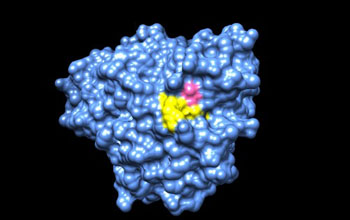Binding of Cysteine Residues Reduces Severity of Multiple Sclerosis
By LabMedica International staff writers
Posted on 04 Oct 2016
A recent paper explained the mode of action of dimethyl fumarate (DMF), the most effective drug currently in use for the treatment of multiple sclerosis (MS).Posted on 04 Oct 2016
MS, which affects more than 200 million people worldwide, is an inflammatory disease in which the myelin sheaths around the axons of the brain and spinal cord are damaged by autoimmune attack, leading to demyelination and scarring as well as a broad spectrum of signs and symptoms.

Image: A model of the crystal structure of adenosine deaminase, one of the protein targets of DMF. The amino acid labeled by DMF is shown in pink, and neighboring residues associated with a human immunodeficiency are shown in yellow (Photo courtesy of The Scripps Research Institute).
Dimethyl fumarate (DMF) is an electrophilic drug that is used to treat autoimmune conditions, including multiple sclerosis and psoriasis. DMF was developed by Biogen (Cambridge, MA, USA) as a capsule containing microtablets for the treatment of multiple sclerosis, under the code name BG-12. It was approved by the [U.S.] Food and Drug Administration under the trade name Tecfidera for the treatment of adults with relapsing forms of MS in March 2013. Despite the approval, the mechanism of action of DMF has been unclear but may involve the covalent modification of proteins or DMF serving as a prodrug that is converted to monomethyl fumarate (MMF).
Investigators at the Scripps Research Institute (La Jolla, CA, USA) reported in the September 13, 2016, online edition of the journal Science Signaling that they had succeeded in determining DMF's mechanism of action. They found that DMF, but not MMF, blocked the activation of primary human and mouse T-cells. Using a quantitative, site-specific chemical proteomic platform, they placed the sensitivity of DMF at greater than 2400 cysteine residues in human T-cells. Cysteine residues sensitive to DMF, but not MMF, were identified in several proteins with established biochemical or genetic links to T-cell function. DMF blocked the activation of T-cells by targeting two cysteine residues on the immune cell-signaling enzyme PKCθ, thereby preventing PKCθ from associating with CD28, another protein needed for proper T-cell activation.
“This study shows the value of applying large-scale chemical profiling methods to primary human cells to gain insights into the mechanism of action of an important immunomodulatory drug,” said senior author Dr. Benjamin F. Cravatt, professor of chemical physiology at the Scripps Research Institute.
Related Links:
Biogen
Scripps Research Institute













